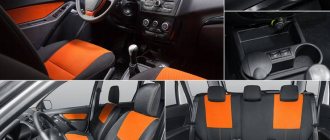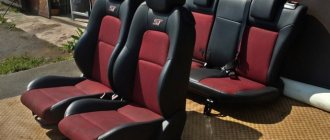Body dimensions and weight of the Lada Priora car - hatchback, station wagon, sedan, coupe, long
The ideal car is different for everyone - it all depends on why they are buying it. Priora is perfect for both the younger generation and the older. The weight that it can lift varies - for example, the station wagon received a voluminous trunk that can accommodate more things. The width of the Priora remains unchanged - exactly 164 cm. The weight of the car ranges from 1578 to 1598 kg.
Hatchback
When it comes to overall dimensions, the Lada Priora cannot but rejoice - you can drive with it even in the narrowest yard. The curb weight of the hatchback is 1163 kg, the maximum permissible is 1578 kg. The trunk volume is 360 liters, and with the seats folded down – 705 liters. Height is 143.5 cm, length – 421 cm.
Sedan
The dimensions of the sedan are slightly different, but the weight of the car remains the same. The trunk volume is 430 liters. The sedan body dimensions are 142 cm in height, length is 435 cm.
Station wagon
The improved technical characteristics of the Lada Priora station wagon allow you to seriously load the trunk - they took care of the reinforced suspension in advance. Unlike the hatchback, the station wagon has a length of 13 cm longer - 434 cm. The height is 150.8 cm. The trunk volume is 444 liters and 777 liters with the seats folded down. The total weight can be equal to 1598 kg.
Coupe
The three-door hatchback Lada Priora was produced in a sports version and featured improved characteristics - after restyling, there were 123 horses under its hood. The body elements had to be redone, which did not affect the dimensions so much. Length is 424.3 cm, height 143.5 cm.
Long body
The extended Priora is the Premier version, premium. Its base was lengthened by 17.5 cm, the rear door was made larger, and an additional section was added to the glass. Under the hood there is a noticeable advantage - more “horses” are needed to pull a heavier car. The salon is decorated elegantly and stylishly. The width remains the same - 168 cm, the length is 452.5 cm, and the height is 142 cm. The curb weight is 1100 kg, and the trunk volume remains the same - 430 liters.
Restyling Lada Priora 2013
The 2013 restyling consisted of some changes regarding the appearance, some equipment, interior and engine. Among such changes in Prior we will name:
- A slightly modified exterior geometry, which, however, makes no sense to describe, since visually Priora before and after restyling remained almost indistinguishable in appearance;
- Replacing the radiator grille with an elongated “honeycomb”, slightly tilting the car into the now fashionable “organic” style, characterized by biological forms;
- Improved external lighting technology, thanks to which the car’s dimensions have become clearer in the dark. In particular, the area of the reflectors has been increased, LED sections for side lights and brake lights have been added, which are both brighter and more responsive when switched on;
- A dashboard that is implemented differently: instead of four “dials,” the sensor arrows were arranged in two, without compromising functionality. Purely aesthetically it looks better, but from an ergonomic point of view, a lot depends on habit;
- An increased number of pictograms flashing on the dashboard, making it easier to figure out which lighting equipment is faulty;
- An added niche in the center of the dashboard, in which the on-board computer is placed;
- Extended front seat slides, allowing tall drivers and front passengers to adjust their seat positions more flexibly;
- A box that is more spacious in depth to the right of the driver;
- A more attractive three-spoke steering wheel with an airbag under a triangular cover;
- In the “luxury” configuration – leather upholstery based on a combination of auto fabric and eco-leather;
- New door card design.
Also, since 2013, Priors have been produced in a different engine configuration, from which the 80-horsepower engine was removed, but a new 106 l/s engine was added, which, like everyone else, reaches speeds of up to 183 km/h and reduces fuel consumption to 6. 8 – 6.9 liters per hundred km. This engine is equipped with the “luxury” configurations of the Priora. Of course, such a reduction in fuel consumption is very attractive to the consumer. We can only hope that the developers will continue to work in this direction. In addition, the new engine fits well into Euro-3 and Euro-4 environmental standards, thanks to the closely located catalyst. Due to rapid heating, the catalysis of toxic substances occurs more vigorously, as a result of which a lower concentration of them enters the atmosphere.
The restyled Prior also has a drawback (compared to previous editions of this car): the carpet in the trunk is thinner than its predecessors, which is why the noise level while driving is higher. Motorists are advised to take care of additional sound insulation in the trunk. In addition, the curb weight of the car has increased (to 1185 kg), which is by as much as 100 kg. reduced its cargo capabilities, since the maximum weight remained the same - 1593 kg. for a station wagon, and 1578 kg. for other body variations.
Technical characteristics of Lada Priora hatchback
Tuning Priora hatchback
As for the dimensions, the hatchback is 140 mm shorter than the sedan and 1.5 centimeters higher. The width and wheelbase of the cars are the same. As for wheel sizes, 14-inch wheels are standard on all Priors. The clearance of the Lada Priora hatchback is 165 mm. It is worth noting that the luggage compartment of the hatch is smaller than that of the sedan, however, with the rear seats folded down, the loading space almost doubles. Below are detailed dimensions and dimensions of the machine.
Dimensions, trunk, dimensions of Lada Priora hatchback
- Length - 4210 mm
- Width - 1680 mm
- Height - 1435 mm
- Curb weight / gross weight - 1185 / 1578 kg
- Front/rear wheel track - 1410 / 1380 mm
- Base, distance between front and rear axle - 2492 mm
- Trunk volume - 360 liters
- Trunk volume with seats folded - 705 liters
- Fuel tank volume - 43 liters
- Tire size - 175/65 R14 or 185/60 R14 or 185/65 R14
- Ground clearance of the Lada Priora hatchback is 165 mm
As for power units and transmissions. The Lada Priora is still a front-wheel drive car with a 5-speed manual transmission. An automatic transmission will definitely appear; the manufacturer promises to release a Priora with automatic transmission closer to the fall of 2014.
Interestingly, after restyling, the Lada Priora hatchback lost its 1.6-liter 8-valve power unit. Today the well-known 16-valve engine with a power of 98 hp is offered, plus its more advanced version with a complex exhaust system and passive supercharging, which already produces 106 hp. The gas distribution mechanism still functions thanks to the tension belt and idler roller. Avtovaz claims that the belt has a fairly long service life. However, it is advisable to change the belt regularly. Below are the parameters of the Priora hatchback engines.
Characteristics of the VAZ-21126 engine (98 hp)
- Working volume - 1596 cm3
- Number of cylinders/valves - 4/16
- Power hp/kW - 98/72 at 5600 rpm
- Torque - 145 Nm at 4000 rpm
- Maximum speed - 183 kilometers per hour
- Acceleration to the first hundred - 11.5 (manual transmission 5) seconds
- Fuel consumption in the combined cycle - 6.9 (manual transmission 5) liters
Characteristics of the VAZ-21127 engine (106 hp)
- Working volume - 1596 cm3
- Number of cylinders/valves - 4/16
- Power hp/kW - 106/78 at 5800 rpm
- Torque - 148 Nm at 4200 rpm
- Maximum speed - 183 kilometers per hour
- Acceleration to the first hundred - 11.5 (manual transmission 5) seconds
- Fuel consumption in the combined cycle - 6.8 (manual transmission 5) liters
Weight of hatchback Lada Priora (VAZ 21723)
The curb weight of the VAZ 21723 hatchback is:
- 1088 kg – produced before 2013. Here it is taken into account that the car is fully equipped, fully fueled, and driven by a driver whose weight is 75 kg. Passengers and cargo are not transported;
- In 2013, after restyling, the curb weight began to reach 1185 kg.
It must be said that the total weight (i.e., the maximum weight of a fully loaded vehicle at which it can be used) remained the same after restyling, namely 1578 kg. This means that the cargo capacity of the hatchback after restyling was reduced by about 100 kg, despite the same trunk size.
Weight of LADA Priora
The carrying capacity of the VAZ Priora I 1.8 MT sedan is 490 (kg).
Weight of popular modifications:
Curb weight of LADA Priora modifications of different generations:
- VAZ Priora I 1.6 MT sedan (2007 - 2013): 1088 (kg) 1578 (kg).
- VAZ Priora I 1.6 MT hatchback (2008 - 2013): 1088 (kg) 1578 (kg).
- VAZ Priora I 1.6 MT station wagon (2013 - present): 1185 (kg) 1593 (kg).
- VAZ Priora I 1.8 MT sedan (2014 - present): 1088 (kg) 1578 (kg).
The value of the permissible gross vehicle weight is indicated in parentheses.
Car load capacity:
The arithmetic difference between a vehicle's gross vehicle weight and its curb weight is the vehicle's payload capacity. For example, for the VAZ Priora I 1.8 MT sedan, the load capacity is determined as follows:
Important: the VAZ Priora I 1.6 MT station wagon is one of the heaviest cars in the model range, its curb weight is 1185 (kg), and the total permissible weight is 1593 (kg).
The head car of the family of Russian cars of the III group of small class LADA Priora is the VAZ-2170.
Weight of body and parts of Lada Priora Hatchback
The curb weight of the Lada Priora Hatchback for all modifications ranges from 1163 (kg) to 1185 (kg).
Weight of typical modifications:
01.6 l., Gasoline, Mechanics, 5 speed, Front:
- Curb weight: 1163 (kg);
- Bare body weight: 300-360 (kg);
- Permissible gross weight: 1578 (kg);
- Load capacity: 415 (kg);
1.6 l., Petrol, Robot, 5 st., Front:
- Curb weight: 1185 (kg);
- Bare body weight: 300-360 (kg);
- Permissible gross weight: 1578 (kg);
- Load capacity: 393 (kg).
How is mass calculated:
According to generally accepted rules, the total mass includes the following parameters:
- the design of the car itself, including the complete set;
- standard equipment: tools, fire extinguisher, spare tire;
- full refills of operating materials: fuel, oils, coolant;
- a driver conventionally assumed to be a person weighing 75 (kg).
Important: in addition to the curb weight, manufacturers sometimes indicate the permissible weight, which includes the weight of the permissible cargo and passengers.
Performance characteristics of the Priora car engine: 126 and 127, how many horsepower and torque
The technical characteristics of the Priora car engine show 98 and 106 horsepower on board. This applies to engines with a displacement of 1.6 liters.
- Motor - 98 horsepower received number 21126. Maximum torque - 4000 rpm at 145 Nm.
- Motor - 106 horsepower is listed under number 21127, torque - 4,200 rpm at 148 km.
Motor 21127 is a modified version of the 126 model, but both of them are available with sixteen valves. In addition, the Priora has two eight-valve engines with a displacement of 1.6 liters, which produce 81 and 87 hp, but they are not as common as newer versions. Interestingly, there are engines with a volume of 1.8 liters.
- The first 1.8 liter engine produces 98 hp. (21127 also works), but the torque is 3000 rpm at 160 Nm.
- The 123 hp engine, which was installed on sports versions, produces 4000 rpm at 165 Nm.
Compared to the weight of the car, sixteen-valve engines are sufficient for free movement.
As for the technical condition, the VAZ-21126 and subsequent models are superior to eight-valve versions of engines, which is why car owners choose them more often. The most common “layout” is the Priora sedan with a 21126 engine and a manual transmission.
Pros and cons of a white car
Advantages of painting a Priora white hatchback car:
• Of course, a chic appearance! White color can visually increase volume. Therefore, clean and sparkling in the sun, as if from a picture, the white Priora hatchback always has an impressive and at the same time elegant appearance.
• In dry weather, dust and dirt are much less visible on it than on cars with a dark color. Pollution becomes noticeable only from a close distance, but from a distance the car appears clean. Accordingly, cleaning costs are reduced.
• White color tends to reflect sunlight. This is especially felt in the summer heat. The white Priora hatchback (photo below) heats up much less.
• It is clearly visible on the road, including at night. This most likely determines the statistics of accidents - white cars get into them much less often.
• The purer the white color of your Lada, the less susceptible it will be to fading. In case of repairs and the need for touch-up, it will be much easier to choose a shade that best matches the original one.
• Small scratches and chips are much less noticeable. This is because paint primer is usually white. Therefore, if the scratch is shallow, then it is not visible.
• White Priora hatchback lends itself very well to modernization. Tuning (pictured), which will make your car original, can be done with your own hands.
Characteristics (performance characteristics): Priora gearboxes
Priora is equipped with two gearboxes:
- mechanical;
- robotic.
The five-speed manual transmission is always stable. The owner’s task is to monitor it and give it proper care, without relying on the car to “fix itself.” The gear ratios are such that they make the car with six-valve engines reach “hundreds” in just 11 seconds.
The robotic automatic transmission also comes with five speeds. It is a slight modification of the old reliable Japanese Jatco box. According to AvtoVAZ, it is not inferior in acceleration to cars with manual transmission. Errors such as kicks during overclocking may occur. They can be removed by reprogramming the ECU. The clutch is a dry single-plate clutch with a diaphragm pressure spring inside. The clutch release drive is cable with automatic adjustment.
Engines on Lada Priore hatchback
The 5-door hatchback VAZ 2172, produced since 2007, is equipped with three engines with different rated power, volume 1596 cc:
- Eight-valve 81-horsepower engine with a maximum speed of 172 km/h with a fuel consumption of 7.6 liters per 100 km. when driving in mixed mode. This is the least economical of all Priora engines, although it is the cheapest. Currently, Priors are no longer equipped with it;
- 16-valve, 89-horsepower, capable of accelerating the car to 176 km/h. Fuel consumption in the combined cycle is slightly lower, namely 7.3 l/100 km;
- 98 horsepower: this 16-valve engine accelerated the hatchback to 183 km/h and consumed 7.4 l/100 km in the combined cycle; Until 2013, the 3-door hatchback coupe was equipped with only one engine – 98 l/s, which gave this car the same technical characteristics as its 5-door brother.
Engine Priora Hatchback after restyling 2013
In 2013, the creators of the Priora decided to update its design, improve ergonomics and retrofit the car according to the requirements of the time, as a result of which the 81-horsepower and 89-horsepower engines were removed from the package. Instead, new 16-valve engines are installed, albeit of the same volume:
- at 98 l/s, giving a maximum speed of 183 km/h, acceleration to “hundreds” in 11.5 seconds, and consuming 6.9 liters of fuel per 100 km;
- 106-horsepower, which has the same speed characteristics, but slightly reduces fuel consumption (up to 6.8 liters of AI-95).
Characteristics of Priora hatchback
| Engine | 1.6 l, 16-cl (Euro-3) |
| Length, mm | 4210 |
| Width, mm | 1680 |
| Height, mm | 1420 |
| Base, mm | 2492 |
| Front wheel track, mm | 1410 |
| Rear wheel track, mm | 1380 |
| Luggage compartment volume, dm 3 | 400 |
| Weight in running order, kg | 1088 |
| Gross vehicle weight, kg | 1578 |
| Permissible total weight of a towed trailer with brakes, kg | 800 |
| Permissible total weight of the lettered trailer without brakes, kg | 500 |
| Wheel formula/drive wheels | 4x2/front |
| Car layout diagram | front-wheel drive, front engine, transverse |
| Body type/number of doors | hatchback/5 |
| engine's type | gasoline, four-stroke |
| Supply system | Electronically controlled distributed injection |
| Number and arrangement of cylinders | 4, in-line |
| Engine displacement, cm 3 | 1596 |
| Maximum power, kW/rpm | 72/5600 |
| Maximum torque, Nm at rpm | 145/4000 |
| Fuel | unleaded gasoline AI-95 (min) |
| Fuel consumption by driving cycle, l/100 km | 7,2 |
| Maximum speed, km/h | 183 |
| Transmission | With manual control |
| Number of gears | 5 forward, 1 reverse |
| Main gear ratio | 3,7 |
| Steering | rack and pinion type, electric power steering |
| Tires | 185/65 R14 86(H) 175/65 R14 82(H) 185/60 R14 82(H) |
| Fuel tank capacity | 43 |
Vehicle body and layout
Body type VAZ 2171 is a five-seater, five-door station wagon. The fifth door is solid and opens upward. The overall dimensions of the Lada Priora station wagon (body length, width and height) are 4210, 1680 and 1420 mm, respectively. The height is indicated taking into account the roof rails, which are not removable. For the Lada Priora station wagon, 10 body color options are offered: from black and dark red to white and silver. The "Lada Priora" station wagon in "Snow Queen" color is most suitable for southern regions, since it heats up less from the sun. In summer, cars of this color will not be so hot.
The vehicle's wheelbase (the distance between the front and rear axles) is 2492 mm. The front track is 1410 mm, the rear is slightly larger, its size is 1380 mm. Ground clearance (or ground clearance) is 170 mm. The trunk of the Priora station wagon has a volume of 444 cubic dm, and with the rear row seats folded, the volume will increase to 777 cubic dm, but the seats do not fold flat. Lada Priora 2171 has a front-wheel drive layout with a front transverse engine. The wheel arrangement is 4×2 (the car has 4 wheels, 2 of which are driving).
In the AvtoVAZ Lada Priora model line, the station wagon is closest to the Kalina station wagon. Which is better: a Kalina station wagon or a Priora station wagon, it is impossible to determine for sure. “Kalina” is 30 cm shorter, and its trunk is 30 liters smaller. But the Priora is no longer produced, so it is impossible to buy a completely new car, just as it is impossible to test drive a Lada-Priora station wagon at a car dealership.
Suspension characteristics
The Priora's chassis was designed for smooth driving over bumps and obstacles, as well as driving along a country road. Of course, the VAZ-2170 is not an SUV, but it can easily go through many places. The front part of the suspension is independent, and the rear part is semi-independent, which makes the car softer.
Many owners almost immediately replace the anti-roll bar arms along with the struts with a sports kit - so that the car does not wobble when making a sharp turn. Telescopic shock absorbers consistently dampen vibrations when passing obstacles, so there will be no problems with it. VAZ-2170 is a front-wheel drive car.
- Front suspension is MacPherson type with longitudinal braces.
- The rear suspension is also with trailing arms. It has a U-shaped transverse beam, to which a torsion-type anti-roll bar is attached.
As for the ground clearance, for the pre-restyling version it was 165 mm, and for the restyled version it was 170 mm. The wheelbase is 249.2 cm, the front track width is 141 cm, the rear track is 138 cm. The suspension can be lowered or raised if desired - ready-made kits for modernization are available for open sale.
Dimensions
The Lada Priora with a hatchback body has the most “modest” dimensions in its series. The length of the five-door version is only 4.24 meters, the three-door version is slightly shorter - 4.21. The height parameters are average, in comparison with the low-set sedan and the high “station wagon” - 1.43 meters.
The width is the same as other body types - 1.68 meters. Almost all versions have a clearance height of 16.8 centimeters, with the exception of the “Sport” line, where it is slightly lower.
Technical modification data
The modification is a good budget car. It belongs to class B and has a high degree of environmental friendliness - Euro4.
How much does a Hatchback body weigh? In factory configuration, without load, its weight is only 1088 kilograms.
Compared to other versions of the Priora, the suspension was not strengthened here. The front spring remained independent, and the rear was partially independent. The front brake is ventilated and has a disc locking type, the rear brakes are drum brakes. The use of a robotic automatic transmission in the modification made the car “friendlier” and easier to drive, even for inexperienced drivers.
The headlight glass has been changed in many ways to better distribute light. The body, interior, steering wheel and multimedia devices were also slightly changed.
Engine after restyling
The technical characteristics of the Lada Priora hatchback have changed somewhat after restyling in 2013. In the new version only 2 engines were released:
- In the younger model, the engine has become more economical (consumption of only 6.9 liters), with increased power - 98 horsepower. Maximum acceleration is 183 kilometers.
- In the older version, the engine became more powerful - 106 horsepower, but with the same speed characteristics. Consumption dropped to 6.8 liters.
Body
In all versions of the Priora, the bodywork is mediocre. Drivers and experts had 2 complaints:
Susceptibility to rust. The body is made of ordinary steel, without alloying additives. For this reason, after the first winter it begins to actively rust and it will not be possible to stop this process.
Poor paintwork. Some noticed that it began to fall off in large “chips.” You will have to constantly visit the paint shop to paint over them, otherwise the corrosion process will be unstoppable.
Transmission
Initially, the hatchback came with a manual transmission. In fact, it was a strengthened version of the gearbox from the 110th Lada. Drivers immediately noted the poor quality of the mechanics, which became known for having very poor synchronizers. Often the handle simply “jumped” out of gear or the desired mode simply did not turn on.
The release lever began to knock just 3 months after purchase, and unclear shifts were observed immediately from the passenger compartment.
Subsequently, the restyled version of “2180” received updated mechanics, which worked much smoother. The sudden knocks disappeared and shifts became smooth. Afterwards, AvtoVAZ updated the gearbox and installed a robotic version, which received mixed reviews. However, it is very reliable and convenient; there are no reviews about its inoperability.
Brake system
The front and rear brakes are different. There are ventilated disc brakes with a single-piston floating caliper and automatic adjustment of the gap between the pads and the disc at the front, and drum brakes at the rear. The brake system is diagonal, dual-circuit, hydraulic. Equipped with a vacuum booster.
It is possible to work with the traction control system. You can also install disc brakes at the rear instead of standard drum brakes. The new braking system will also support ABS. The parking brake is manual, on a cable with drive of the rear wheels.
Modifications of Lada Priora 2172
The pre-restyling model in the hatchback body was sold on our market from 2008 to 2013.
There was no need to choose a box before restyling, but there were several units at once:
| 1.6 l 21114 80 hp 120 Nm and 5-speed manual transmission VAZ 2170 |
| 1.6 l 21116 87 hp 140 Nm and 5-speed manual transmission VAZ 2170 |
| 1.6 l 21126 98 hp 145 Nm and 5-speed manual transmission VAZ 2170 |
The updated hatchback model was offered on our market only from 2013 to 2015.
After modernization, a new manual transmission, a robot and a more powerful 16-valve engine appeared:
| 1.6 l 21116 87 hp 140 Nm and 5-speed manual transmission VAZ 2181 |
| 1.6 l 21126 98 hp 145 Nm and 5-speed manual transmission VAZ 2170 |
| 1.6 l 21127 106 hp 148 Nm and 5-speed manual transmission VAZ 21806 |
| 1.6 l 21127 106 hp 148 Nm and 5-speed gearbox AMT 2182 |
Technical characteristics of Lada Priora hatchback 1.6 liter 8v 5-speed manual transmission
| Motor power | 87 hp |
| Torque | 140 Nm |
| Acceleration to 100 km/h | 12.5 s |
| Max. speed | 176 km/h |
| Fuel type | AI-95 |
| Consumption in the city | 9.9 l |
| Highway consumption | 5.7 l |
| Mixed flow | 7.3 l |
| Volume of the tank | 43 l |
| Trunk volume | 360 l |
Disadvantages, breakdowns and problems of Lada Priora 2172
Body
The body is highly susceptible to corrosion and rust may appear after the first winter. The paintwork is not the most durable; chips form quickly and immediately turn yellow.
Salon
The interior is very cramped, especially in the back, and there are a lot of ergonomic miscalculations. Noise insulation is weak, squeaks appear from the first km and only intensify with mileage.
But most of all the problems are caused by electrics; something constantly breaks down. This is some kind of endless process, you fix one thing and immediately something else breaks.
Engine
Four 1.6-liter engines have similar problems, let's list them in a single list:
- Sensors often fail, and in updated internal combustion engines there is an electronic throttle valve
- The thermostat may unexpectedly jam, which will lead to overheating and gasket breakdown
- Lubricant leaks regularly occur, as well as fogging of the crankcase ventilation breather
- The worst thing is a broken timing belt due to old age, jammed rollers or pump
Transmission
The main manual transmission of the VAZ 2170 is a reinforced version of the manual transmission from the Lada 110 and is known for weak synchronizers, release knocks and unclear shifting.
The new mechanics of the VAZ 2180 with a cable drive are much more pleasant to use. The VAZ 2182 robot received very mixed reviews, read a separate article about it.
Suspension
But there are much fewer questions regarding the chassis of the car. The suspension here is quite reliable; by 100,000 km, steering tips, wheel bearings, and ball joints are usually replaced.
The brakes are not bad if you buy normal pads instead of the stock ones as soon as possible. The first years of production there were failures with the electric power steering, but then everything got better.
Operational deficiencies
Like most domestic cars, Priora has a rather weak paint coating, as a result of which the body of used cars is covered with chips and scratches. However, the problem with the low quality of metal and the level of anti-corrosion treatment is much more acute. As a result, the car quickly begins to become covered with rust, showing hot spots in various places. The most susceptible to corrosion are wheel arches, doors, sills and hood.
Engine
Both gasoline engines have proven themselves well during operation and are unpretentious in maintenance. The biggest problems are caused by electronic sensors, which cannot serve as a standard for durability. Quite often the throttle valve and the gasket between the head and the cylinder block fail due to the low quality of gasoline. When it gets dirty, the car stalls and loses traction. During operation of the machine, it is necessary to pay sufficient attention to the operation of the cooling system. Quite quickly, especially in the summer, the thermostat can fail, which can lead to overheating of the engine with all the ensuing consequences. Car enthusiasts will not be pleased with the long service life of the ignition coil and fuel pump. The car has a timing belt drive and, according to the manufacturer, its service life is 200 thousand kilometers. However, do not forget that as a result of a broken belt, the valve bends and you have to do a major overhaul of the engine. Therefore, owners of LADA Priora 2008 recommend changing it along with the rollers and pump at least every 100 thousand km.
Transmission
Despite the fact that the car is equipped with no alternative to a manual transmission, this gearbox cannot serve as a standard of reliability. The main disadvantage is weak synchronizers, which, however, is typical for manual transmissions installed on all AvtoVAZ models. The main sign of their failure is a characteristic crunch, which is clearly audible when changing gears. Priora received enhanced clutch from, but the problem of the limited service life of the release bearing was never solved. The service life of the transmission can be extended by using high-quality oil and regularly changing the fluid in the box, which must be done at least once every 75 thousand kilometers.
Chassis and steering
Surely many car enthusiasts are familiar with the problems of domestic cars associated with the short service life of the suspension. However, LADA Priora in this component can compete on equal terms with most budget foreign cars presented on the secondary market. Stabilizer bushings fail most quickly. As a rule, this happens already at 10–20 thousand km. mileage Following them, the stabilizer struts will have to be changed. Steering tips and wheel bearings will last about 40 - 50 thousand km. Replacement of ball joints and support bearings will be required after a mileage of 60 - 70 thousand km. Shock absorbers, CV joints and silent blocks of front levers can last 100 - 120 thousand kilometers. The original brake pads may not survive the first 10 thousand km, so the driver will have to quickly replace them with better analogues.
Poor quality operation of the electric power steering can cause certain troubles. The main signals of such a malfunction are jerking and heaviness when turning the steering wheel. The problem can be resolved by cleaning the electrical wiring contacts of the unit.
Other faults
Both the quality of the materials used for interior decoration and the level of assembly itself deserve great criticism, as a result of which car enthusiasts will have to put up with numerous extraneous sounds throughout the entire period of operation. Moreover, every year there will be more and more of them. Additional installed sound insulation and pasting of elements with vibration-absorbing materials do not help get rid of them either. The driver will constantly have to deal with malfunctions of electrical equipment, which occur mainly due to oxidation of contacts.
What is good about the Lada Priora hatchback?
The answer to this question lies in the plane of what advantages such a body variation has in general. Firstly, it is a sportier and more dynamic look, which is preferred by young buyers, even taking into account the fact that the sedan looks more solid. Secondly, its compact size and the shortest wheelbase make it easier to maneuver and park in urban environments. Above we have already described the dimensions of the hatchback. Thirdly, the absence of a protruding stern, which creates difficulties when parking and reversing. Fourthly, a wide luggage opening (despite the fact that the Priora sedan has a larger trunk in volume), allowing for the stowage of large cargo.
Thus, the Priora hatchback is an excellent choice for those who do not burden themselves too much with pressing problems, preferring to devote time to the simple joys of life. This is a car for driving, not for transportation, which will be appreciated by young car enthusiasts, athletes, and those who do not intend to grow old.
Technical characteristics of Lada Priora Hatchback 1.6 MT 98 hp
Main characteristics
| Brand | VAZ |
| Model | Lada Priora Hatchback |
| Modification | Lada Priora Hatchback 1.6 MT 98 hp |
| Model year | 2013 |
| Body type | Hatchback |
| Number of doors | 5 |
| Number of seats | 5 |
| Country of assembly | Russia |
Performance characteristics
| Type of fuel | AI-95 |
| Acceleration time to 100 km/h | 11.5 sec |
| Maximum speed | 183 km/h |
| Fuel consumption in the urban cycle | 9.1 l per 100 km |
| Fuel consumption on the highway | 5.5 l per 100 km |
| Combined fuel consumption | 6.9 l per 100 km |
| Power reserve | 473 – 782 km |
| Fuel costs per year (with a mileage of 100 km per day) | 119 629₽ |
| Transport tax * (Moscow) | 1 176₽ |
| OSAGO * (Moscow, age over 22 years, experience over 3 years) | 7 570₽ |
Dimensions and dimensions
| Length | 4210 mm |
| Width | 1680 mm |
| Height | 1435 mm |
| Ground clearance | 165 mm |
| Front track | 1410 mm |
| Rear track | 1380 mm |
| Wheelbase | 2492 mm |
| Turning diameter | 11.6 m |
Weight
| Curb weight | 1163 kg |
| Full mass | 1578 kg |
| Load capacity | 415 kg |
Volumes
| Trunk volume | 360 l |
| Fuel tank volume | 43 l |
Engine
| engine's type | Petrol |
| Number of cylinders / arrangement | 4/Inline |
| Engine power, hp/rpm | 98/5600 |
| Engine displacement | 1596 cm³ |
| Torque, Nm/rpm | 145/4000 |
Transmission
| Drive unit | Front |
| Gearbox type | Mechanical, 5 gears |
Steering wheel
| Power steering | Electric booster |
Climate
| Climate control | Climate control |
Suspension
| Front suspension | Independent, McPherson |
| Rear suspension | Semi-independent, lever |
Brakes
| Front brakes | Disk |
| Rear brakes | Drums |
Tires and wheels
| Tire size | 175/65 R14 |
Trailer
| Trailer weight / braked | 500/800 kg |
Dimensions and dynamic data of Priora hatchback
The solid hatchback has small but sufficient dimensions: length - 4.21 m, width - 1.68 m, height - 1.43 m. The internal space was reduced due to the small external dimensions, but had minimal impact on the comfort of travel for second-row passengers.
The technical characteristics of the Priora hatchback also had a slight impact on the trunk volume. In the sedan, the luggage compartment volume is 430 liters, and in the hatchback it is 360 liters.
The model is equipped with 1.6 liter petrol engines. The power plant is combined with manual or 5-speed automatic transmissions. Engine power is 87, 98 and 106 hp, the maximum possible speed is 176 (183) km/h. The technical characteristics of the hatchback indicated for the Lada Priora lead to the following fuel consumption in mixed mode: from 6.6 to 7.3 liters. The maximum figure applies to a model with an automatic transmission.











